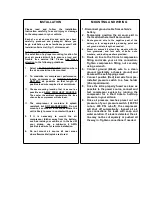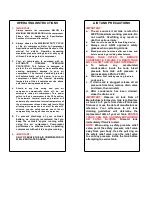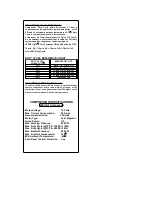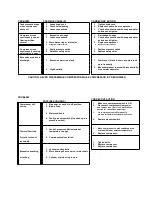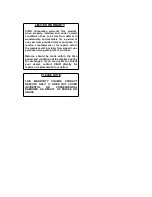
TROUBLESHOOTING CHART
PROBLEM
POSSIBLE CAUSE(S)
CORRECTIVE ACTION
Tank pressure drops
1. Loose drain cock
1.
Tighten drain cock
when compressor
2. Check valve leaking
2.
Replace check valve or compressor
shuts off
3. Loose connections
3.
Check all connections with soap and water
solution and tighten
Compressor runs
1. Excessive air usage
1.
Decrease air usage
continuously and air
2. Loose connections
2.
Check all connections with soap and water
flow lower than
solution and tighten
normal
3. Worn piston ring or inlet valve
3.
Replace compressor
4. Clogged air filter element
4.
Replace air filter element
Compressor runs
1. Faulty pressure switch
1. Replace pressure switch
continuously causing
2. Defective safety valve
2. Replace safety valve
safety valve to open.
Excessive moisture in
discharge
1. Excessive water in air tank
1. Drain tank, tilt tank to drain and drain tank
more frequently
2. High humidity
2. Move compressor to area with less humidity,
or use water separator
CAUTION: NEVER DISASSEMBLE COMPRESSOR WHILE COMPRESSOR IS PRESSURIZED.
PROBLEM
POSSIBLE CAUSE(S)
Compressor will
1. No power, or switch in off position.
not run
2. Blown Fuse.
3. Motor overheats.
4. Faulty pressure switch (if hooked up to a
pressure switch).
Thermal Overload
1. Lack of proper ventilation/ambient
temperature too high.
Protector cuts out
2. Compressor valves failed.
repeatedly
Excessive knocking
1. Loose mounting bolts
2. Worn bearing on eccentric or motor shaft
or rattling
3. Cylinder or piston ring is worn
CORRECTIVE ACTION
1.
Make sure compressor switch is ON
2.
Disconnect compressor from power
and replace fuse. (Refer to Specifications
section for correct fuse amperage.)
3.
Let compressor cool off for about 30
minutes for thermal overload switch reset.
4.
Replace pressure switch
1.
Move compressor to well ventilated area,
or area with lower ambient temperature
2.
Replace compressor
1.
Tighten bolts
2.
Replace compressor
3.
Replace compressor


